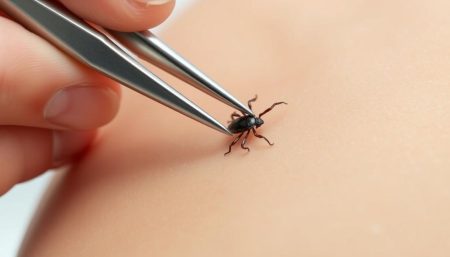Ingrown toenail surgery is a key treatment for onychocryptosis. This painful condition happens when the nail grows into the skin. It helps those with ingrown toenails that don’t get better with simple care.
People thinking about surgery often wonder about the process and recovery. This guide will cover the basics. It includes understanding why ingrown toenails happen, what to do before surgery, and how to care for yourself after.
Learning about the surgery, getting ready for it, and knowing what to expect during recovery is important. With the right treatment, including surgery, people can manage this common problem.
Understanding Ingrown Toenail Surgery
Ingrown toenail surgery is a treatment for onychocryptosis, a painful condition. It happens when the nail grows into the skin around it. This surgery is needed when other treatments don’t work.
Definition and Medical Terminology
Onychocryptosis is the medical term for ingrown toenails. It happens when the nail edge grows into the skin. This can cause pain, swelling, and sometimes infection. Surgery aims to fix this and bring lasting relief.

Common Causes of Onychocryptosis
Several things can lead to ingrown toenails:
- Improper nail trimming techniques
- Tight or ill-fitting footwear
- Trauma to the toe
- Genetic predisposition
- Excessive sweating
When Surgery Becomes Necessary
First, doctors try non-surgical treatments. Surgery is considered when:
| Condition | Surgical Consideration |
|---|---|
| Recurring infections | Multiple infections despite proper care |
| Severe pain | Pain interferes with daily activities |
| Failed conservative treatments | No improvement after non-surgical approaches |
| Chronic ingrown nail | Persistent issue lasting several months |
Knowing these points helps decide if surgery is needed. Talking to a podiatrist can guide you on whether surgery is right for you.
Types of Surgical Procedures for Ingrown Toenails
Ingrown toenail surgery offers several options for patients seeking relief from persistent pain and discomfort. Podiatrists typically choose between partial and complete nail avulsion techniques, depending on the severity of the condition.
Partial nail avulsion involves removing only the affected portion of the toenail. This procedure is less invasive and allows for quicker healing. In contrast, complete nail avulsion requires the removal of the entire toenail, often recommended for severe or recurring cases.
Matrixectomy is another key part of ingrown toenail surgery. This technique targets the nail matrix, the tissue responsible for nail growth. By destroying part or all of the matrix, surgeons can prevent future ingrowth.
| Procedure | Description | Recovery Time |
|---|---|---|
| Partial Nail Avulsion | Removal of affected nail portion | 2-4 weeks |
| Complete Nail Avulsion | Removal of entire toenail | 4-6 weeks |
| Chemical Matrixectomy | Destruction of nail matrix using chemicals | 3-5 weeks |
| Surgical Matrixectomy | Surgical removal of nail matrix | 4-8 weeks |
Advancements in surgical techniques have greatly improved patient outcomes. Modern toenail removal procedures often use laser technology or minimally invasive approaches. This reduces pain and speeds up recovery times.
Pre-operative Assessment and Preparation
Before surgery for an ingrown toenail, a detailed pre-operative assessment is needed. This step is vital to ensure the procedure is both safe and effective. The preparation includes several important parts to reduce risks and improve results.
Medical History Evaluation
Reviewing a patient’s medical history is key. They should share any allergies, current medications, and health issues. This info helps the surgeon plan the surgery just right for each patient.
Required Tests and Examinations
Some tests might be needed based on the patient’s health:
- Blood work to check for infections or clotting issues
- X-rays to assess bone structure
- Nail cultures if infection is suspected
Medications and Dietary Guidelines
Patients might need to change their medications before surgery. Here are some common guidelines:
| Medication Type | Recommendation |
|---|---|
| Blood thinners | Stop 7-10 days prior |
| NSAIDs | Discontinue 3-5 days before |
| Diabetes medication | Adjust as per doctor’s advice |
Usually, patients are asked to fast for 8-12 hours before the surgery. Proper preparation makes the surgery smoother and helps in a quicker recovery.
Step-by-Step Surgical Process
Ingrown toenail surgery is a common podiatry procedure that offers relief from persistent pain and discomfort. Understanding the process can help patients feel more at ease before their appointment.
The surgical process starts with thorough sterilization of the affected area. Your podiatrist will clean your toe and surrounding skin with an antiseptic solution to prevent infection. Next, local anesthesia is administered to numb the area, ensuring you remain comfortable throughout the toenail removal procedure.
Once the anesthesia takes effect, the podiatrist starts the toenail removal. Depending on the severity of your condition, they may perform a partial or complete nail avulsion. In partial removal, only the ingrown portion is excised. For recurring issues, complete removal might be necessary.
After nail removal, the surgeon may apply a chemical solution to the nail matrix. This step, known as chemical matrixectomy, helps prevent regrowth of the problematic nail portion. The toe is then bandaged to protect the treated area and promote healing.
- Sterilization of the affected area
- Administration of local anesthesia
- Partial or complete toenail removal
- Optional chemical matrixectomy
- Bandaging of the treated toe
The entire ingrown toenail surgery typically takes 30 to 60 minutes. Most patients can walk immediately after the procedure, though it’s advisable to have someone drive you home. Remember, proper aftercare is key for successful healing and preventing future ingrown toenails.
Partial vs Complete Nail Avulsion Procedures
Ingrown toenail surgery often involves nail avulsion, which is the removal of part or all of the toenail. The choice between partial and complete nail removal depends on the severity of the condition and other patient factors.
Partial Nail Removal Benefits
Partial nail avulsion is less invasive and preserves most of the nail. This procedure is ideal for mild cases of ingrown toenails. It allows for quicker healing and maintains the nail’s protective function.

Complete Nail Removal Considerations
For severe or recurring cases, complete toenail removal may be necessary. This procedure eliminates the entire nail, including the nail matrix. While it offers a more definitive solution, it results in longer recovery times and temporary loss of the nail’s functions.
Chemical Matrixectomy Options
A chemical matrixectomy often accompanies nail avulsion procedures. This treatment uses chemicals to destroy part of the nail matrix, preventing regrowth of the problematic nail portion. It’s an effective method for reducing the likelihood of ingrown toenail recurrence.
| Procedure | Recovery Time | Recurrence Risk |
|---|---|---|
| Partial Nail Avulsion | 1-2 weeks | Moderate |
| Complete Nail Avulsion | 3-4 weeks | Low |
| Chemical Matrixectomy | 2-3 weeks | Very Low |
Your podiatrist will recommend the most suitable toenail removal procedure based on your specific case, ensuring effective treatment and minimizing the risk of recurrence.
Anesthesia Options and Pain Management
During ingrown toenail surgery, anesthesia is key to ease pain. Most patients get local anesthesia, which numbs the toe but keeps them awake. This method helps in quick recovery and has few side effects.
The surgeon injects a numbing agent near the toenail. Patients might feel a pinch, but soon the area is numb. During the surgery, patients are alert but pain-free. They might feel pressure or tugging.
After surgery, pain relief often comes from over-the-counter drugs. Doctors might give stronger meds for those who can’t handle pain well. Non-pharmaceutical methods like ice packs and elevating the foot also help.
Following the surgeon’s pain management advice is key for a smooth recovery. Most patients feel little pain after the surgery, with pain going away in a few days. Knowing about anesthesia and pain relief options helps patients feel more confident and prepared for the surgery.
Post-Surgery Recovery Timeline
After ingrown toenail surgery, patients need to understand the recovery process. This timeline helps set realistic expectations for healing and resuming normal activities.
First 48 Hours After Surgery
The first two days are key for toenail surgery recovery. Patients should rest with their foot elevated to reduce swelling. Pain management typically involves over-the-counter medications. Keeping the surgical site dry and clean is essential to prevent infection.
Week One Recovery Milestones
In the first week after surgery, patients often see big improvements. Swelling decreases, and pain lessens. Most can return to light activities while wearing loose-fitting shoes. Daily dressing changes help monitor healing progress.
Long-term Healing Process
Complete recovery from ingrown toenail surgery takes several weeks. Patients gradually return to normal footwear and activities. The nail may take months to regrow fully, depending on the extent of the procedure.
| Recovery Stage | Timeline | Key Points |
|---|---|---|
| Immediate Post-Op | 0-48 hours | Rest, elevate foot, manage pain |
| Early Recovery | 3-7 days | Reduced swelling, light activities |
| Full Recovery | 2-6 weeks | Return to normal activities |
| Nail Regrowth | 3-12 months | Varies based on procedure type |
Following these recovery guidelines helps ensure successful healing after ingrown toenail surgery. Patients should always consult their podiatrist for personalized advice throughout the recovery process.
Potential Complications and Risk Factors
Ingrown toenail surgery is usually safe, but there are risks. Knowing these can help you decide on treatment.
Infection is a big worry after surgery. Look out for pain, redness, swelling, or discharge. Keeping the wound clean is key to avoiding this.
Healing slowly can happen, mainly in people with circulation or diabetes issues. This makes recovery longer and more painful. Following your doctor’s advice closely can help avoid this.
Ingrown toenails might come back, even after surgery. This is because the nail matrix wasn’t fully removed. Some might need more surgeries to fix this.
- Bleeding or hematoma formation
- Allergic reactions to anesthesia
- Damage to surrounding tissues
- Chronic pain or numbness
Smoking, bad nutrition, and some medicines can raise risks. People with weak immune systems or diabetes are at higher risk too.
Talking to your podiatrist about your health and worries is important. They can give you advice tailored to you. This helps ensure the best results from your surgery.
Aftercare Instructions and Wound Management
Proper aftercare is key for a smooth toenail surgery recovery. By following your doctor’s advice, you can heal well and avoid complications.
Cleaning and Dressing Changes
Keep the surgical area clean to avoid infections. Wash it with mild soap and warm water every day. Pat it dry with a clean towel and change the dressing as your podiatrist says. This is vital for healing from an ingrown nail.
Activity Restrictions
During the early stages, limit your physical activity. Don’t put pressure on the toe and wear loose shoes. Your doctor will tell you when you can go back to normal activities.
| Activity | Restriction Period |
|---|---|
| Walking | 24-48 hours |
| Bathing | 24 hours |
| Regular shoes | 1-2 weeks |
| Sports | 2-4 weeks |
Signs of Normal Healing
Knowing what normal healing looks like is important. You might see swelling, redness, and some pain at first. These should get better over time. If you see more pain, a lot of bleeding, or signs of infection, call your doctor right away.
Remember, everyone heals differently after toenail surgery. Stick to these tips and talk to your podiatrist if you have any worries. This way, you can get the best results from your ingrown nail treatment.
Cost and Insurance Coverage
It’s important for patients to know about the costs of ingrown toenail surgery. The price can change based on how complex the case is and where you go for treatment.
Average Procedure Costs
Ingrown toenail surgery costs between $200 and $1,000. If you need part of your nail removed, it’s usually cheaper than removing the whole nail. You might also have to pay extra for anesthesia or the place where the surgery is done.
| Procedure Type | Average Cost Range |
|---|---|
| Partial Nail Removal | $200 – $500 |
| Complete Nail Avulsion | $500 – $1,000 |
Insurance Requirements
Many insurance plans cover ingrown toenail surgery if it’s needed for health reasons. You should talk to your insurance about what you need, like a referral or prior approval.
Payment Plan Options
If you’re paying yourself, many podiatrists offer payment plans. You might be able to pay a little each month or use a medical credit card. Some places even work with financing companies to help you out.
Knowing about costs, insurance, and payment plans helps you decide on treatment for your ingrown toenail. It’s a good idea to talk about money with your doctor before you schedule anything.
Prevention Strategies After Surgery
After getting treatment for an ingrown toenail, it’s important to prevent it from coming back. Taking good care of your nails is the first step. Cut your nails straight across, not too short, and don’t round the corners. This helps stop ingrown toenails from happening again.
Choosing the right shoes is also key. Wear shoes that give your toes room to breathe. Avoid tight or high-heeled shoes. This way, you put less pressure on your toes and lower the chance of ingrown nails.
Keeping your feet clean is also vital. Wash your feet every day and keep them dry. This stops bacteria from growing. If you see redness or pain, see a podiatrist right away.
- Trim nails straight across
- Wear properly fitting shoes
- Practice good foot hygiene
- Monitor for early signs of ingrown nails
Checking your feet regularly can catch problems early. By following these steps, you can lower the need for more treatments in the future.
Choosing a Qualified Podiatric Surgeon
Finding the right podiatric surgeon for your ingrown toenail surgery is key. A skilled surgeon can greatly improve your treatment’s success. Here are important things to think about when picking a surgeon for your ingrown toenail treatment.
Credentials to Look For
When looking for surgeons, check their qualifications. Make sure they are board certified in podiatric medicine and have training in foot and ankle surgery. These signs show they are experts in treating ingrown toenails.
Questions to Ask Your Provider
Make a list of questions for your consultation. Ask about their experience with ingrown toenail surgeries and their success rates. Find out about their surgical techniques and how they handle complications and post-operative care. This will help you understand their expertise and treatment approach.
Reading Patient Reviews
Patient reviews give great insights into a surgeon’s skills and how they treat patients. Look for feedback on their ingrown toenail surgeries. Notice comments on pain management, recovery time, and overall satisfaction. While some negative reviews are okay, too many warnings might be a sign of trouble.
By carefully considering these points, you can make a smart choice for your podiatric surgeon. This ensures you get top-notch care from a qualified expert, boosting your chances of a good outcome for your procedure.
Long-term Success Rates and Outcomes
Ingrown toenail surgery has shown great success over time. Studies reveal that the right procedures can cut down recurrence rates to just 5%. This makes it a very effective treatment for those with chronic ingrown toenails.
The method used in surgery affects long-term results. Partial nail avulsion with matrixectomy often leads to fewer recurrences than complete nail removal. Proper aftercare and prevention strategies also play a big role in the surgery’s success.
Most patients are very happy with the results of ingrown toenail surgery. They often see big improvements in their life, like less pain and better mobility. Some might notice small changes in their nail, but most find these minor compared to the relief from pain.
Knowing about these long-term results helps patients choose the best treatment. With such high success rates and positive feedback, ingrown toenail surgery is a reliable choice for lasting relief from onychocryptosis.
FAQ
Q: What is ingrown toenail surgery?
A: Ingrown toenail surgery is a procedure to treat ingrown toenails. It removes part or all of the nail that has grown into the skin. This helps to relieve pain and prevent future problems.
Q: When is ingrown toenail surgery necessary?
A: You might need surgery if other treatments don’t work. This includes when you have recurring infections, severe pain, or chronic inflammation. People with diabetes may also need surgery to avoid serious issues.
Q: What are the different types of ingrown toenail surgeries?
A: There are a few types of surgeries. Partial nail avulsion removes part of the nail. Complete nail avulsion removes the whole nail. Matrixectomy destroys part of the nail root to stop it from growing back. The right choice depends on how bad the problem is and what you need.
Q: How long does the recovery process take after ingrown toenail surgery?
A: Recovery time varies, but most people can get back to normal in 1-2 weeks. It can take 3-4 weeks to fully heal. The first 48 hours are key for wound care. Always follow your podiatrist’s advice.
Q: What are the possible complications of ingrown toenail surgery?
A: Complications can include infection, slow healing, too much bleeding, and nail growth issues. Rarely, you might have a bad reaction to the anesthesia or ongoing pain. It’s important to follow your podiatrist’s care instructions to avoid these problems.
Q: How can I prevent ingrown toenails after surgery?
A: To avoid getting ingrown toenails again, trim your nails right and wear roomy shoes. Keep your feet clean and avoid hurting your toes. Regular check-ups and acting fast if you notice an ingrown toenail are also key.
Q: Is ingrown toenail surgery covered by insurance?
A: Many insurance plans cover the surgery if it’s needed. But, coverage can change, and some plans might need you to get approval first. It’s a good idea to check with your insurance and talk to your podiatrist about costs.
Q: What type of anesthesia is used for ingrown toenail surgery?
A: The surgery is usually done under local anesthesia. This numbs the toe and area around it. It lets you stay awake but not feel pain during the procedure.
Q: How do I choose a qualified podiatric surgeon for my ingrown toenail surgery?
A: Look for a podiatrist who is certified and has experience with ingrown toenail surgeries. Ask about their success rates and read what other patients say. Make sure you’re comfortable with their approach and how they communicate with you.
Q: What are the long-term success rates of ingrown toenail surgery?
A: Most people find a lot of relief and enjoy a better quality of life after surgery. But, success can depend on the surgery method and your situation. Talk to your podiatrist about what you can expect based on your case.


















